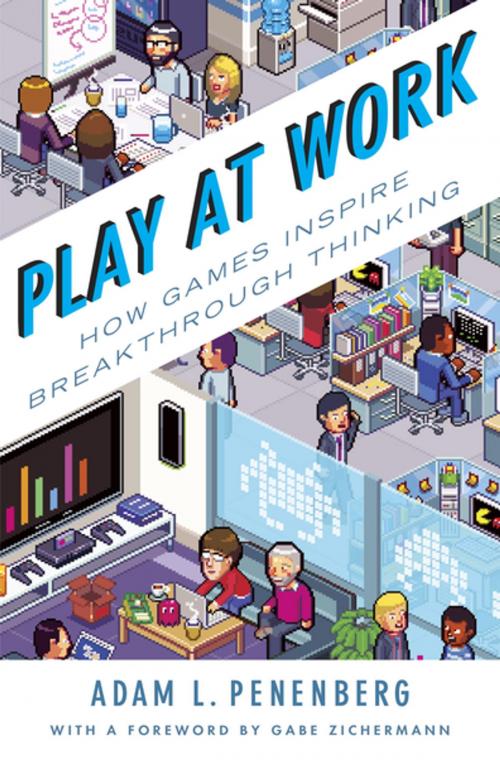Play at Work
How Games Inspire Breakthrough Thinking
Nonfiction, Health & Well Being, Psychology, Creative Ability, Business & Finance, Human Resources & Personnel Management, Organizational Behavior, Business Reference| Author: | Adam L. Penenberg | ISBN: | 9781101623022 |
| Publisher: | Penguin Publishing Group | Publication: | October 3, 2013 |
| Imprint: | Portfolio | Language: | English |
| Author: | Adam L. Penenberg |
| ISBN: | 9781101623022 |
| Publisher: | Penguin Publishing Group |
| Publication: | October 3, 2013 |
| Imprint: | Portfolio |
| Language: | English |
**Do games hold the secret to better productivity? **
If you’ve ever found yourself engrossed in Angry Birds, Call of Duty, or a plain old crossword puzzle when you should have been doing something more productive, you know how easily games hold our attention. Hardcore gamers have spent the equivalent of 5.93 million years playing World of Warcraft while the world collectively devotes about 5 million hours per day to Angry Birds. A colossal waste of time? Perhaps. But what if we could tap into all the energy, engagement, and brainpower that people are already expending and use it for more creative and valuable pursuits?
Harnessing the power of games sounds like a New-Age fantasy, or at least a fad that’s only for hip start-ups run by millennials in Silicon Valley. But according to Adam L. Penenberg, the use of smart game design in the workplace and beyond is taking hold in every sector of the economy, and the companies that apply it are witnessing unprecedented results. “Gamification” isn’t just for consumers
chasing reward points anymore. It’s transforming, well, just about everything.
Penenberg explores how, by understanding the way successful games are designed, we can apply them to become more efficient, come up with new ideas, and achieve even the most daunting goals. He shows how game mechanics are being applied to make employees happier and more motivated, improve worker safety, create better products, and improve customer service.
For example, Microsoft has transformed an essential but mind-numbing task—debugging software—into a game by having employees compete and collaborate to find more glitches in less time. Meanwhile, Local Motors, an independent automaker based in Arizona, crowdsources designs from car enthusiasts all over the world by having them compete for money and recognition within the community. As a result, the company was able to bring a cutting-edge vehicle to market in less time and at far less cost than the Big Three automakers.
These are just two examples of companies that have tapped the characteristics that make games so addictive and satisfying. Penenberg also takes us inside organizations that have introduced play at work to train surgeons, aid in physical therapy, translate the Internet, solve vexing scientific riddles, and digitize books from the nineteenth century. Drawing on the latest brain science as well as his firsthand reporting from these cutting-edge companies, Penenberg offers a powerful solution for businesses and organizations of all stripes and sizes.
**Do games hold the secret to better productivity? **
If you’ve ever found yourself engrossed in Angry Birds, Call of Duty, or a plain old crossword puzzle when you should have been doing something more productive, you know how easily games hold our attention. Hardcore gamers have spent the equivalent of 5.93 million years playing World of Warcraft while the world collectively devotes about 5 million hours per day to Angry Birds. A colossal waste of time? Perhaps. But what if we could tap into all the energy, engagement, and brainpower that people are already expending and use it for more creative and valuable pursuits?
Harnessing the power of games sounds like a New-Age fantasy, or at least a fad that’s only for hip start-ups run by millennials in Silicon Valley. But according to Adam L. Penenberg, the use of smart game design in the workplace and beyond is taking hold in every sector of the economy, and the companies that apply it are witnessing unprecedented results. “Gamification” isn’t just for consumers
chasing reward points anymore. It’s transforming, well, just about everything.
Penenberg explores how, by understanding the way successful games are designed, we can apply them to become more efficient, come up with new ideas, and achieve even the most daunting goals. He shows how game mechanics are being applied to make employees happier and more motivated, improve worker safety, create better products, and improve customer service.
For example, Microsoft has transformed an essential but mind-numbing task—debugging software—into a game by having employees compete and collaborate to find more glitches in less time. Meanwhile, Local Motors, an independent automaker based in Arizona, crowdsources designs from car enthusiasts all over the world by having them compete for money and recognition within the community. As a result, the company was able to bring a cutting-edge vehicle to market in less time and at far less cost than the Big Three automakers.
These are just two examples of companies that have tapped the characteristics that make games so addictive and satisfying. Penenberg also takes us inside organizations that have introduced play at work to train surgeons, aid in physical therapy, translate the Internet, solve vexing scientific riddles, and digitize books from the nineteenth century. Drawing on the latest brain science as well as his firsthand reporting from these cutting-edge companies, Penenberg offers a powerful solution for businesses and organizations of all stripes and sizes.















